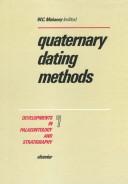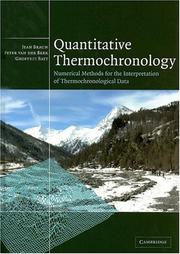| Listing 1 - 5 of 5 |
Sort by
|

ISBN: 0444423923 9786611756147 1281756148 0080868487 9780444423924 9780080868486 9781281756145 6611756140 Year: 1984 Volume: vol 7 Publisher: Amsterdam New York Elsevier
Abstract | Keywords | Export | Availability | Bookmark
 Loading...
Loading...Choose an application
- Reference Manager
- EndNote
- RefWorks (Direct export to RefWorks)
Quaternary Dating Methods
Issue --- Radioactieve datering. (Versch. onderwerpen) --- Geologische tijd. (Versch. onderwerpen) --- Géologie stratigraphique. Quaternaire. (Mélanges) --- Datation radioactive. (Mélanges) --- Temps géologique. (Mélanges) --- Geologie (Stratigrafische). Kwartair. (Versch. onderwerpen) --- Geological time. --- Geology, Stratigraphic --- Radioactive dating. --- Age determination, Radiometric --- Dating, Radioactive --- Dating, Radiometric --- Fission dating methods --- Radiometric age determination --- Radiometric dating --- Geochronometry --- Radioactivity --- Quaternary Period --- Age of rocks --- Geochronology --- Geochrony --- Rocks --- Time, Geological --- Chronology --- Historical geology --- Sequence stratigraphy --- Measurement --- Age
Periodical
ISSN: 18971695 17338387
Abstract | Keywords | Export | Availability | Bookmark
 Loading...
Loading...Choose an application
- Reference Manager
- EndNote
- RefWorks (Direct export to RefWorks)
Geochronometry --- Radioactive dating --- Radiocarbon dating --- Radioactive dating. --- Geochronometry. --- Radiocarbon dating. --- Archaeology --- Carbon dating --- Carbon-14 dating --- Dating, Radiocarbon --- Dating of fossils --- Dating of rocks --- Fossils --- Geological chronometry --- Geological time --- Rocks --- Age determination, Radiometric --- Dating, Radioactive --- Dating, Radiometric --- Fission dating methods --- Radiometric age determination --- Radiometric dating --- Dating --- Measurement --- Archaeological dating --- Time measurements --- Radioactivity
Book
ISBN: 0231546785 9780231546782 9780231186704 0231186703 Year: 2019 Publisher: New York, NY
Abstract | Keywords | Export | Availability | Bookmark
 Loading...
Loading...Choose an application
- Reference Manager
- EndNote
- RefWorks (Direct export to RefWorks)
There are few fields of science that carbon-14 has not touched. A radioactive isotope of carbon, it stands out for its unusually long half-life. Best known for its application to estimating the age of artifacts-carbon dating-carbon-14 helped reveal new chronologies of human civilization and geological time. Everything containing carbon, the basis of all life, could be placed in time according to the clock of radioactive decay, with research applications ranging from archeology to oceanography to climatology.In Hot Carbon, John F. Marra tells the untold story of this scientific revolution. He weaves together the workings of the many disciplines that employ carbon-14 with gripping tales of the individuals who pioneered its possibilities. He describes the concrete applications of carbon-14 to the study of all the stuff of life on earth, from climate science's understanding of change over time to his own work on oceanic photosynthesis with microscopic phytoplankton. Marra's engaging narrative encompasses nuclear testing, the peopling of the Americas, elephant poaching, and the flax plants used for the linen in the Shroud of Turin. Combining colorful narrative prose with accessible explanations of fundamental science, Hot Carbon is a thought-provoking exploration of how the power of carbon-14 informs our relationship to the past.
Carbon --- Radiocarbon dating. --- Radioactive dating. --- Age determination, Radiometric --- Dating, Radioactive --- Dating, Radiometric --- Fission dating methods --- Radiometric age determination --- Radiometric dating --- Geochronometry --- Radioactivity --- Carbon dating --- Carbon-14 dating --- Dating, Radiocarbon --- Archaeological dating --- Radioactive dating --- Radiocarbon --- Isotopes. --- Measurement --- Radiocarbon dating --- isotopes --- Carbone --- Datation --- Datation radioactive. --- Méthode du carbone 14 --- Méthode du carbone 14. --- Carbon - isotopes --- Méthode du carbone 14 --- Méthode du carbone 14.

ISBN: 0521830575 9780521830577 9780521830577 9780511616433 9781107407152 9780511161711 0511161719 0511241585 9780511241581 0511160410 9780511160417 0511160984 9780511160981 0511616430 1280567554 9781280567551 1107148170 9781107148178 9786610567553 6610567557 0511313136 9780511313134 110740715X Year: 2006 Publisher: Cambridge Cambridge University Press
Abstract | Keywords | Export | Availability | Bookmark
 Loading...
Loading...Choose an application
- Reference Manager
- EndNote
- RefWorks (Direct export to RefWorks)
Thermochronology, the study of the thermal history of rocks, enables us to quantify the nature and timing of tectonic processes. First published in 2006, Quantitative Thermochronology is a robust review of isotopic ages, and presents a range of numerical modeling techniques to allow the physical implications of isotopic age data to be explored. The authors provide analytical, semi-analytical and numerical solutions to the heat transfer equation in a range of tectonic settings and under varying boundary conditions. They then illustrate their modeling approach built around a large number of case studies. The benefits of different thermochronological techniques are also described. Computer programs on an accompanying website at www.cambridge.org/9781107407152 are introduced through the text and provide a means of solving the heat transport equation in the deforming Earth to predict the ages of rocks and compare them directly to geological and geochronological data. Several short tutorials, with hints and solutions, are also included.
Earth temperature. --- Geochronometry. --- Heat --- Plate tectonics. --- Radioactive dating. --- Transmission. --- Tectonics, Plate --- Geodynamics --- Heat transfer --- Thermal transfer --- Transmission of heat --- Energy transfer --- Ground temperature --- Surface air temperature of the earth --- Surface temperature of the earth --- Temperature --- Age determination, Radiometric --- Dating, Radioactive --- Dating, Radiometric --- Fission dating methods --- Radiometric age determination --- Radiometric dating --- Geochronometry --- Radioactivity --- Dating of fossils --- Dating of rocks --- Fossils --- Geological chronometry --- Geological time --- Rocks --- Time measurements --- Measurement --- Dating
Book
ISBN: 8847011973 8847011981 Year: 2010 Publisher: Milano : Springer,
Abstract | Keywords | Export | Availability | Bookmark
 Loading...
Loading...Choose an application
- Reference Manager
- EndNote
- RefWorks (Direct export to RefWorks)
Chi possiede il passato? Come si leggono le ossa antiche? E cosa ci dicono sulle nostre origini gli artifatti, il polline e il DNA dell’età glaciale? Usando tecniche sempre più raffinate, gli scienziati riescono a ricostruire gli ambienti del passato profondo e i primi esseri umani che ci vivevano. I lettori di ossa esamina i fatti e i miti sull’arrivo dei primi uomini in Australia; il DNA degli attuali Aborigeni australiani rivela le loro origini; le teorie degli hobbit indonesiani; e chi o cosa ha ucciso i marsupiali giganti dell’Australia. Le scoperte australiane trovano eco nei dibattiti sulla misteriosa fine dei Neanderthal e gettano luce sull’evoluzione umana. Ma, come sempre, gli scienziati sono divisi. I lettori di ossa mette in evidenza un mondo di coloriti personaggi e un dibattito appassionato – e alcune idee veramente bizzarre. Questo libro chiarisce le idee a chi è incuriosito da affermazioni e contro-affermazioni su chi ha fatto cosa, quando a e a chi nel profondo passato della preistoria e spiega in modo lineare la scienza su cui si basano le recenti metodologie investigative. Senza timore di essere controverso, I lettori di ossa è destinato a riscaldare il dibattito sul passato dell’umanità.
Aboriginal Australians -- Antiquities. --- Aboriginal Australians -- History. --- Human beings -- Origin. --- Human evolution -- Australia. --- Human evolution. --- Human remains (Archaeology) -- Australia. --- Prehistoric peoples -- Australia. --- Anthropology --- Physical Sciences & Mathematics --- Social Sciences --- Prehistoric Anthropology --- Sciences - General --- Aboriginal Australians --- Prehistoric peoples --- Accelerator mass spectrometry --- Radioactive dating --- Antiquities. --- History. --- Age determination, Radiometric --- Dating, Radioactive --- Dating, Radiometric --- Fission dating methods --- Radiometric age determination --- Radiometric dating --- Cavemen (Prehistoric peoples) --- Early man --- Man, Prehistoric --- Prehistoric archaeology --- Prehistoric human beings --- Prehistoric humans --- Prehistory --- Science. --- Mass spectrometry. --- Geology. --- Anthropology. --- Archaeology. --- Science, general. --- Mass Spectrometry. --- Geochronometry --- Radioactivity --- Mass spectrometry --- Particle accelerators --- Human beings --- Antiquities, Prehistoric --- Measurement --- Science, Humanities and Social Sciences, multidisciplinary. --- Mass spectra --- Mass spectrograph --- Mass spectroscopy --- Mass spectrum analysis --- Mass (Physics) --- Nuclear spectroscopy --- Spectrum analysis --- Geognosy --- Geoscience --- Earth sciences --- Natural history --- Archeology --- Auxiliary sciences of history --- History --- Antiquities --- Primitive societies --- Social sciences
| Listing 1 - 5 of 5 |
Sort by
|

 Search
Search Feedback
Feedback About UniCat
About UniCat  Help
Help News
News